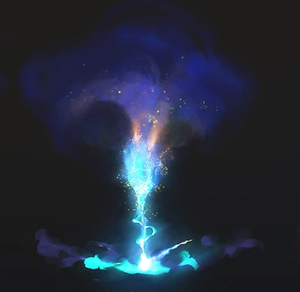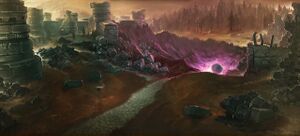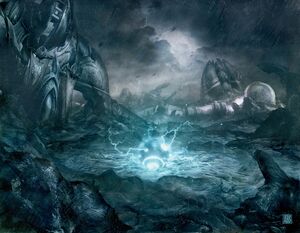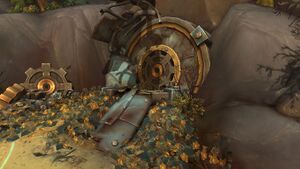User:Ximothy/FalloutAzeroth
“War. War never changes.
The Mogu waged war to gather slaves and wealth. The Kaldorei built an empire for its lust for Magic and territory. Gul'dan forged disparate clans into a near unstoppable war machine.
But war? War never changes.
From 27 to 37 ADP, war was waged over the resources that could be acquired on a dying world. Only this time, the spoils of war were also its weapons: Azerite. For these resources, The Horde conquer Kalimdor and burn the World tree, the Alliance annexed Lordaeron and drove the undead to extinction, and any neutral entity that did not choose a side was absorbed or destroyed by the world powers.
In 42 ADP, the storm of world war would come to an end. In a singular, Final Hour most of the planet was reduced to cinders. And from the ashes of Azerite devastation, a new civilization would struggle to arise. ”
The world of Azeroth, once full of life and diversity, died. The Alliance and Horde found their differences and grudges irrevocable and waged total war on one another. The name of this war varied, some called it the Alliance-Horde war, others the Fourth War. For the survivors and generations onwards it was known simply as the Last War.
In the wastelands left behind the world has seen a slow but eventual rise of new settlements, organisations and, of course, conflicts. However plaguing this new world are horrid mutations, rogue automatons and raiders who pillage settlements instead of creating their own resources.
Brief History
This worlds' timeline diverged early from the mainstream's. When Deathwing broke the World Pillar and erupted into Azeroth causing the Cataclysm he scarred the world far deeper than initially many believed. As conflict waged across Azeroth desposits of what became known as Azerite begun to bleed out from Azeroth's wounds which both factions were quick to look for potential military uses for. A major turning point was early on in the war, months after Deathwing's defeat above the Maelstrom, when the Horde created a Mana Bomb empowered by the Focusing Iris and leveled Theramore. The Alliance would take the wreckage of this Mana Bomb and hand it over to a new science and technology department, the Tinker Tank, who would find a way to replicate the Focusing Iris using the Azerite, however this was a highly violatile mix. The Horde would be able to steal these plans and replicate it of their own. The war came to a standstill after both factions would unleash these Azerite Mana-Bombs on Pandaria after the natives of the continent united against them both.
The devastation caused the ten year war to halt however not end. The world fell under an air of uneasiness as both sides warily watched the other for who would make the first strike as all knew that if, or when, one fired these highly destructive bombs the other side would retaliate. No longer was winning the Last War possible, only ensuring the other side would be destroyed too. This portion of the Last War saw both sides developing potential means of enduring the eventual apocalypse, however the leadership of both sides struggled with such defeatist mentality. 42 years after the Dark Portal opened, when it was the afternoon in the Eastern Kingdoms and morning in Kalimdor, the first strike was made. Which side fired first is not a known fact in the modern world with the descendants of each side blaming the others. Whoever fired the first shot it led to global retaliation and within a few hours brought the sudden end of the world as it was known.
With the destruction of both the Alliance and Horde as well as the near total annilihation of the worlds' population the Azeroth entered a 'quiet' age where there were few settlements left. However even for those who survived the initial strike were not spared further horror as the Purple Rain would follow, killing much of the remaining life. The Azerite Mana Bombs were inherently unstable and caused horrific mutations on those exposed to its affects, leading to the rise of mutants and other horrors. Perhaps none was as terrible as the Cancer, as high amounts of radiation floated in the air and waters everywhere, ensuring any living mortal would not live beyond the age of eighty, if violence or other disease did not kill them first.
The collapse of civilization also saw the rise of brutal, tribal gangs that roamed wastelands referred to collectively as 'Raiders', who would live off of their constant needling raids against the few settlements, inhabited by the 'Settlers'. Other groups would rise, some existed before the Final Hour while others were formed in its wake. Remnants of the old world are everywhere and are often highly dangerous, some places are irradiated to hell while others have machines that went haywire or those capable of controlling them are long dead.
Some descendants think of the time before the bombs as some sort of golden age, where resources was plentiful, their air and water wasn't killing them, and security was possible. However if such ideals were true there likely wouldn't have been an Azerite Apocalypse to begin with, and those that brave the dangers of the old world to find its secrets will learn the depths and depravity the Alliance and Horde had sunk to in a desperate bid to win, or at least survive, the Last War.
Dying Neutrality
One of the aspects of the war was the end of neutrality for most of the world. As the Alliance and Horde expanded and built their respective war machines they would go about recruiting or destroying neutral organisations, nations and groups. The Kirin Tor was the first group to join a side in the Last War, under the leadership of Jaina they joined after the Divine Bell inciendent and the Purge of Dalaran. The next year would see the Steamwheedle Cartel fully joining the Horde after the Alliance's blockades of Ratchet and Booty Bay, a result of the goblins refusing to stop making arms for both sides, was broken by the Horde leading cartel to raise the Red flag. The Cenarion Circle would fully commit to the Alliance, while the Earthen Ring would return home to the Horde. Island nations such as the goblins of Kezan and the humans of Kul Tiras would join the Horde and Alliance respectively, leading to violent clashes across the sea. This would even see the Venture Company working exclusively for the Horde, becoming rivals of the Alliance aligned Ashvane Trading Company. The Zandalari joining the Horde gave them an edge in the Great Seas, however the Alliance recruitment of Vrykul helped secure large stretches of land in Northrend. Even pirates and criminals were drawn into the war, with the Horde backed Blackwater Raiders fighting the Alliance aligned Bloodsail Buccaneers over vital trade routes. Nations and groups were consumed in the path of the Last War, whether willingly or not.
The so called Lesser Races such as gnolls, kobolds, quilboars and others were systematically wiped out by the factions land and resource grabbing. Trolls were forced to find refuge in the Horde and Zandalari as the Alliance begun burning their homes in Stranglethorn and Dun Morogh, while the Horde would enslave the remaining centaur to throw them on the frontlines as cannonfodder doomed to die all so they could more easily secure the resources of Maraudon. If any of these lesser races still existed when the bombs fell it and the following "Purple Rain" wiped them out, leaving only a few races left on Azeroth.
Some groups would refuse to join a side, notably the Dragonflights became hostile towards both factions due to various actions each faction committed over the course of the war, such as the Horde's killing of Blues to steal the Focusing Iris and using the Dragonmaw to enslave dragons; and the Alliance's theft of many powerful dragon artefacts and the fact they dropped Naxxramas ontop of a Horde army, plaguing much of Dragonblight their sacred graveyard. However the dragons could not keep up with the advancing technology and soon the Alliance and Horde were slaughtering the flights in great numbers, to the point that by the final days of the Last War dragons were so rare that many thought them completely extinct, with the fates of the various former Aspects being unknown.
The largest movement of neutral factions, however, was the so called Pandaria Empire. As Pandaria was a major battleground between two factions otherwise unaffiliated with the natives, rendering large swathes of the land ruined from over resource harvesting and devastating battles. The Shado-Pan and August Celestials came together and agreed that the Alliance and Horde, though allies in the past against the Mogu and Sha, were proving to be as determintal to their home as those enemies were. When the demands of withdrawal to both factions were ignored the pandaren mobilized against both factions. They recruited many groups such as the Order of the Cloud Serpent and the Pearlfin Jinyu were brought into the fold, with other native groups such as the local hozen and yaungols joining the movement. The Pandaria Empire was active for the last three years of the Last War, during which they forged alliances of their own with the Rajani Mogu, Ramkahen Tol'vir and even the Tortollan Seekers. The Empire's forces were able to achieve victories in both Pandaria and across Azeroth, they lacked the technology development of the two factions and never developed those super weapons of their own. When the Azerite Warheads were created, Pandaria was an easy target as they were deemed incapable of retaliating. Those thoughts were correct as the Pandaren and their allies were devastated by the Warheads and their destruction heralded the pause in the Last War for five years, before the Final Hour.
A Wasted Peace
This Azeroth, in theory, should've been one of the safest ones. The Titan Watchers were able to muster a great spell that trapped the Old Gods, and themselves, into Ny'alotha, the Waking City in an attempt to stop them forever. A great crusade was launched against Argus by the Army of the Light and various cosmic forces in a suicide siege of the demon world, drawing countless demons to the world and detonating the planet in the same way Ner'zhul did to Draenor, killing countless numbers of demons including the upper echelons, and the Titan Pantheon was able to imprison Sargeras in the Seat of the Pantheon at the cost of everyone who partook in the crusade. The machinations of Death never turned in the direction of the Jailer's freedom and the Shadowlands cared not for the fate of mortals on Azeroth when they had a cosmos to look after.
However perhaps in the absence of these cosmic threats that caused the mortal factions to wage Armageddon against one another, or perhaps certain actions and differences could not be reconciled.
Azerite Warheads
The origin Mana Bomb was developed in Outland by the forces of Kael'thas, the first test was against the Cenarion Thicket which led to the deaths of all inside and while it left arcane radiation behind the region was not structually damaged. The second trial was against Kirin'Var Village in Netherstorm and this one was far more destructive, warping magic and destroying the land, killing all within and leaving the taint behind. The elves' further attempts at deploying Mana Bombs were foiled by agents of various factions who interferred with the blood elves' plans, however the legacy of the Mana Bombs was only beginning as some elves, such as one Thalen Songweaver of the Kirin Tor would manage to get the plans.
Years later during the onset of the Fourth War Thalen would contact Hellscream about the Mana Bomb, believing he was able to replicate and amplify the effects but he needed additional power. Warchief Hellscream was interested in using the bomb on Theramore, intending to draw much of the Alliance upper military ranks to the city in order to cripple the Alliance military. He sent agents to get the Focusing Iris from the Blue Dragonflight and Thalen would incorpate it into the Mana Bomb. The assault on Theramore was destined to fail as Garrosh gave the Alliance ample of time to reinforce the city, the only true goal was to take out the Alliance's aerial defence. Once a Horde zeppelin dropped the bomb onto Theramore it resulted in the city being laid waste too, killing many Alliance and changing the face of the war.
For the time being Hellscream put his attention elsewhere rather than continuing to use the Mana Bombs, taking interest in other potential weapons such as the Sha or the newly discovered Azerite. The Alliance were not so quick to disregarde the bomb, however, as their agents recovered the wreckage of the Mana Bomb. The Tinker Tank, a science and technology division of the Alliance formed by the former High Tinker Mekkatorque, worked to replicate the Mana Bomb and sought a replacement for the Focusing Iris. They would discover that Azerite functioned as a suitable alternative, however to achieve the same or greater power the gnomes would irradiate the Azerite, making it more wild and unstable causing a greater reaction. Mekkatorque grew horrified at the invention he was creating, and after agents of the Horde stole these Azerite plans and their goblin and blood elven engineers proved able to quickly replicate these plans.
Nearly ten years into the war, a few years after the people of Pandaria entered the war as a third side, the Alliance and Horde finished developing the warheads and used them against Pandaria at the same time. The timing of this is somewhat suspect; the two sides were too afraid of launching their new Azerite Warheads at one another however the Pandaren lacked these weapons and thus were an easy target. Some modern historians wonder if there was some secret deal between the factions to see the effect of the Azerite WMDs, or if one side fired first and the other quickly fired in tandem. What is clear was the results; total devastation of Pandaria. How much of the continent, if any of it, survived is unknown as reports from both sides state that the destruction was near total and sending scouts into the irradiated wasteland was too hazardus. What this proved was how incredibly dangerous these new weapons were and both sides had them in possession. If either side fired first it would result in mutually assured destruction. The fear of mutual destruction was referred to as Impelled Mutual Preservation, or IMP, as it was the fear of these weapons that led to a five year cease fire.
Arcane Radiation
As part of the process to replace the Focusing Iris element of the Mana Bomb dropped on Theramore the gnomes of the Tinker Tank tried to simply use Azerite, however while this did help make the bomb stronger it was discovered by Oglethorpe Obnoticus, one of the heads of the Tinker Tank, that Azerite discovered near the radioactive wastes of Gnomeregan created a far greater reaction. This reaction was more devastating than even the one to lay waste to Theramore however it also left a far more devastating aftermath, the arcane taint was radioactive in nature and would cause mutations akin to the leprosy the Leper Gnomes suffered, with the animal test subjects beginning to excrete an ooze with some melting into slime lifeforms. The radiation left behind is usually referred to as Taint when its airborne and ooze when its liquidized.
Some races are affected by this radiation differently, with more magically inclined races suffering the worst. Undead and Worgen are heavily affected by the radiation, with Worgen usually going feral and mutating at a near 100% exposure rate unlike most races who can endure minor exposure. Undead usually fall into a mindless, rapid decaying state while worgen turn into a larger, feral form called the Wargs by normal folk. Other races can endure minor amounts, as all of the air and water across Azeroth carries the radiation, with most not showing any signs until tumors start growing with age, with the Cancer keeping lifespans below eighty no matter how long lived the victim's race can actually life for, reducing even long lived races like draenei and elves to a lifespan of a few decades.
Safehouses: Vaults and the Complex
After the Devastation of Pandaria realisation of just how dangerous these weapons were truly hit each faction.
Mekkatorque, head of the Tinker Tank who spearheaded the creation of the Azerite Warheads, would venture to Pandaria personally to see what was left behind and despaired. He scrapped future weapons programs in the Tinker Tank much to the annoyance and demands of his compatriots and instead set about Operation: S.A.F.E to create a means of surviving what he feared was inventiable Azerite apocalypse by constructing great Vaults. He pushed the Alliance Assembly to approve of the program with the help of a Demostration Vault located in Stormwind and required grant money however some were reluctant, Queen Greymane calling such thoughts 'defeatism' however Mekkatorque did have an ally in King Anduin Wrynn and Velen who gave their approval and helped tip the votes. Mekkatorque did not live to see any more Vaults finished, his health rapidly failed as guilt weighed too heavily on the gnome and eventually the stress killed him in his sleep. He was succeeded as head of the Tinker Tank by Tinkmaster Overspark, a far more prideful and morally fluid creator that Mekkatorque always kept on a leash.
Through connections in the SI:7, the Ashvane Trading Company and beyond Overspark would eventually shape these Vaults away from the safehouses that they were advistised as and begun thinking of more strange and morally questionable experiments, fueled by curiousity and a desire to see how far a mortal can be pushed in isolation. He reasoned that living under ground in the case of apocalypse was not ideal and instead sought to use these Vaults as experiments as Overspark came to his own conclusion that the average person did not matter, only science and advancement did. Some of the Vaults were control vaults and thus operated as intended; to safe guard the inhabitants, such as Vault 7, however most were designed with an experiment in mind, such as Vault 9's experiment being on necromancy or Vault 15 being designed to see how multiple cultures would react if forced in a confined space. Locations of old under ground structures were often chosen, for example the Deadmines under Moonbrooke was home to Vault 7, the Goldtooth's Den houses Vault 4, and the Dawning Wood Catacombs under Raven Hill was converted into Vault 9. When the alarms for the Final Hour came thousands were sealed within these Vaults believing themselves safe, however only a few would actually find salvation.
In the Horde, it was Baine Bloodhoof who became increasingly concerned with the potential apocalypse that his fellow leaders seemed unwilling to truly consider. He had sought visions of what was to come however in the months leading to Pandaria's destruction the Spiritwalkers could not see past 42 ADP, giving Baine a sinking feeling that this was the day it would all end. Baine had deep ties to a company of his own, the so called TotemTec that developed ANSHE One, the Horde's largest power station that gave power to all of Mulgore, as well as the smaller Mu'sha Stations that powered a settlement each. He had the Company begin construction of a great Complex to preserve their people, located below Mulgore, however he conspired with others to keep it a secret from Hellscream. The company's president, who was a good friend of Baine's named Gazlowe, would believe Baine in that the end was coming and pulled strings to help get this place built, with some help from other people in high places in the Horde such as Vol'jin and Thrall.
Built under Red Cloud Mesa the Complex was built through siphoning resources and a cover story of harvesting thus far untapped resources under there. As the massive Complex, comprised of multiple Chambers capable of housing hundreds, neared completion Baine considered who would go in. Baine resolved that he did not deserve to survive any Azerite hellfire, that he was assesssoriy to far too many crimes to deserve such fate. Yet as he considered comptratiors and comrades he couldn't help but feel that entire generations had blood on their hands. A dark thought came to him and after wrestling with his morality he set about a grim task, one he hoped would in the end save the races of the Horde; he ordered his Longwalkers to secretly abduct hundreds of infants and young children to be brought to the Complex. There they would be raised by what appeared to be an artifical intelligence program named ELDER, not an acronym just named that way. As Azerite fire engulfed the world, Baine would spend his dying moments thinking on the hundreds of children he had taken to the Complex and hoped that his choice might be forgiven by the spirits of the parents he had wronged, but accepted that perhaps there would be no forgiveness for him. Chambers of orcs, trolls, tauren, pandaren and goblins would endure the end times in the Complex, cared for by ELDER to be slowly released back into an unforgiving world as the massive complex only had so many resources.
Alliance: A Fall From Grace
Tinker-Tank
After the bombing of Theramore and the conflict over Pandaria Mekkatorque saw the need to advance the Alliance quicker than the pace it was going at. As such he stepped down as High Tinker and made a call for the best engineers, alchemists, techno-mages, scientists, blacksmiths and other fields to join him in the creation of the Tinker-Tank. Many new technologies were developed to help advance Alliance territories, with things such as computers being produced. One of Mekkatorque's favourite creations during this time was the original Tinker-Toy, a wrist mounted computer of magic and technology that would help keep track of various things such as the vitals and status of the wearer, a local map to help with navigation, kept track of the date and time, and other functions.
However under Mekkatorque also saw the development of his most hated invention; the Azerite Warhead. After the Alliance recovered the pieces of the Mana Bomb that destroyed Theramore Mekkatorque took these remnants to the Tinker-Tank. Although he was capable of recreating the Mana Bomb it lacked the power the Focusing Iris gave it and so against his better judgement he sought a power replacement, going through several potential replacements before using Azerite infused with Radioactive Wastes that once flooded Gnomeregan. The arcane aftermath left behind by the test run was projected to be able to cause mutations akin to those of Gnomeregan, an ooze like leprosy. However Overspark and Trini convinced him to present this weapon to the Alliance Assembly. After presenting it to the Assembly in a recorded meeting, the Council of Three Hammers, High Tinker Tread Sparknozzle and Genn Greymane approved of the weapon, while the Prophet Velen and Tyrande spoke out against it, stating that using such weapons will only weaken Azeroth as a whole by scarring the land and nature. Anduin was more on the fence, his desire to protect his people winning out and he chose to vote in favour of the weapon.
Despite the overwhelming support of the Assembly, Mekkatorque was utterly guilt ridden over the creation of such a bomb and when he learnt the Horde had stolen the plans to the bomb, he grew sick with guilt and despair. As the year reached its tenth year both factions launched their Azerite Warheads against Pandaria who sought to drive them both from their homeland, reducing the ancient land to a radioactive wasteland. Mekktorque ventured there personally and it broke his heart. As such he sought to totally dismantle the Tinker-Tank's weapons departments and focus on creating Operation: Vault to create a series of Shelters. Mekkatorque died from stress and guilt not long after Pandaria, succeeded by Overspark instead of his preferred successor Elgin Clickspring.
Under Overspark's leadership the Tinker-Tank forgot their morals and became increasingly ruthless in their pursuit for new discoveries and technology. Through deals with other organisations such as the SI:7 and the ATC they conducted immoral experiments. Overspark also changed the mission statement for Operation: Vault, changing the Shelters into horrid experiments with only a few actually operating as expected as 'control shelters'. When the Final Hour came the heads of the Tinker-Tank vanished beyond Shelter 0, their fate largely unknown however what is known that out of the toxic blizzards of Dun Morogh come dangerous mechs and mutants that aren't seen anywhere else.
Members
The original chief head of the Tinker-Tank was its founder Gelbin Mekkatorque who stepped down as High Tinker to personally lead the initiative. His assistant and right hand was Elgin Clickspring who he intended to succeed him however the board ignored the last wishes of the late Mekkatorque and voted someone else in, with Elgin Clickspring leaving the Tinker-Tank over differences. She died in a gyrochopter incident a few months later which was blamed on the Horde. Tinkmaster Overspark came on as the head of Advance Engineering however he would succeed Gelbin as Chief Head of the Tinker-Tank, taking the organisation down a very different path of amorality and a focus on science first, disregarding gnomanity. Oglethorpe Obnoticus was brought on to replace him as the Head of Advance Engineering, with the department's focus being on the actual manufactoring, keeping eyes on the factories and work places as they had the crucial task of ensuring everything was actually built.
Sapphronetta Flivvers was brought on as Head of Mineralogy who had the vital task of Azerite acquisition and distribuption among the other divisions and departments, although earlier on she had some moral complaints she would eventually fall in line and became one of the heads of the Tinker-Tank. The Weapons Division was in charge of designing and creating weapons for the Alliance, with its original leader being the dwarf Nuji Kodosbreath however he would have moral objections with Overspark's leadership and left to join the Ironforge Science Service, being replaced with Toshley who was far more aggressive and introduced live weapon testing on prisoners. The Magi-Tech Department was headed from day one by Gaxim Rustfizzle to successfully marry technology and magic, with them playing vital roles in creating the Tinker-Toy, though they were quick to fall in line with Overspark's amoral leadership. The Alchemy Division was originally headed by the Gilneas Krennan Aranas however the man was killed in a workplace accident, officially, however among the Alliance's upper elchelons it was something of an open secret that he was assassinated. He was replaced by Tally Berryfizz.
By the Final Hour the Heads worked out of Gnomeregan when the sirens rang. Its reported that Overspark, Obnoticus, Flivvers, Toshley, Gaxim and Tally were able to make it inside of Shelter 0 before it was sealed. The fate of these heads of the Tinker-Tank is unknown by the modern wastelands, though some are convinced Shelter 0 is the place those monsters that prowl the toxic blizzards of Dun Morogh are coming from.
SI:7
Stormwind Intelligence, the SI:7 grew from a single kingdom operation to span the entire Alliance, its members drawn from all races that fly the blue banner. It was founded decades ago by Panthonia Shaw and her grandson, Mathias Shaw, would come to lead the group to its final hours. Although once devoted to maintaining the integrity of the Alliance the SI:7 would be one of the largest factors of the Alliance falling into moral degradation being behind many of its worst actions and atrocities, and they have ties to the Shelter experiments of the Tinker-Tank. They would spy on their own people, weeding out sedition and treason regardless of how many innocents may be caught up in their own paranoia, and they are even believed to be responsible for assassinating some Alliance figures, including one of the members of the Council of Three Hammers.
The moral failing of the SI:7 has its ties to the death of King Varian Wrynn who died during the Invasion of Redridge, or the Bloodied Ridges Event, where Horde forces invaded from the occupied Black Rock Spire. The teenage Anduin was crowned once again and Mathias made it his mission to ensure Anduin did not loose his own purity, intending to take on the worst aspects of leadership in secret and become something of the shadow behind the king. Under his leadership several projects were initiated, such as Operation: Fahrenheit and Project: New Lines which had horrific outcomes for the living test subjects. These actions did weigh heavy on Shaw however he never saw himself as a good man doing what had to be done- he knew he was doing horrible things and only took comfort in the idea of the Alliance winning the War. In the final days before the end many of the actions of the SI:7 was discovered by King Anduin who had the leadership arrested including Shaw. Mathias made no excuses for himself and accepted judgement. He was in prison during the Final Hour.
All of the actions the SI:7 committed for the preservation of the Alliance was for nothing as the Alliance was destroyed by Horde warheads during the Final Hour, however the sins of the past were not washed away by Azerite radiation. Project: Red Lines has unleashed savage magically enhanced berserkers onto the wastes, while the Ghost Armor project has allowed a monster to roam the region killing innocents in a blind zeal.









